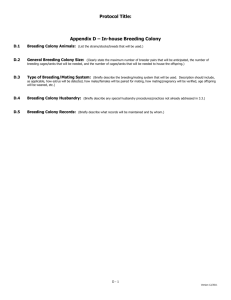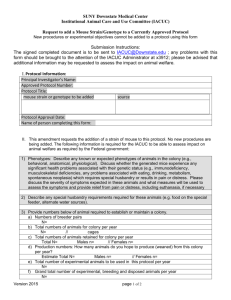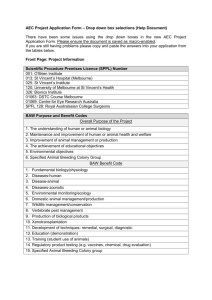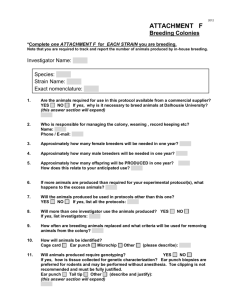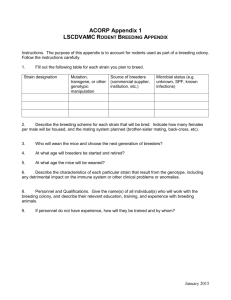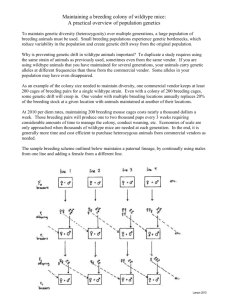BREEDING OF RODENTS
advertisement
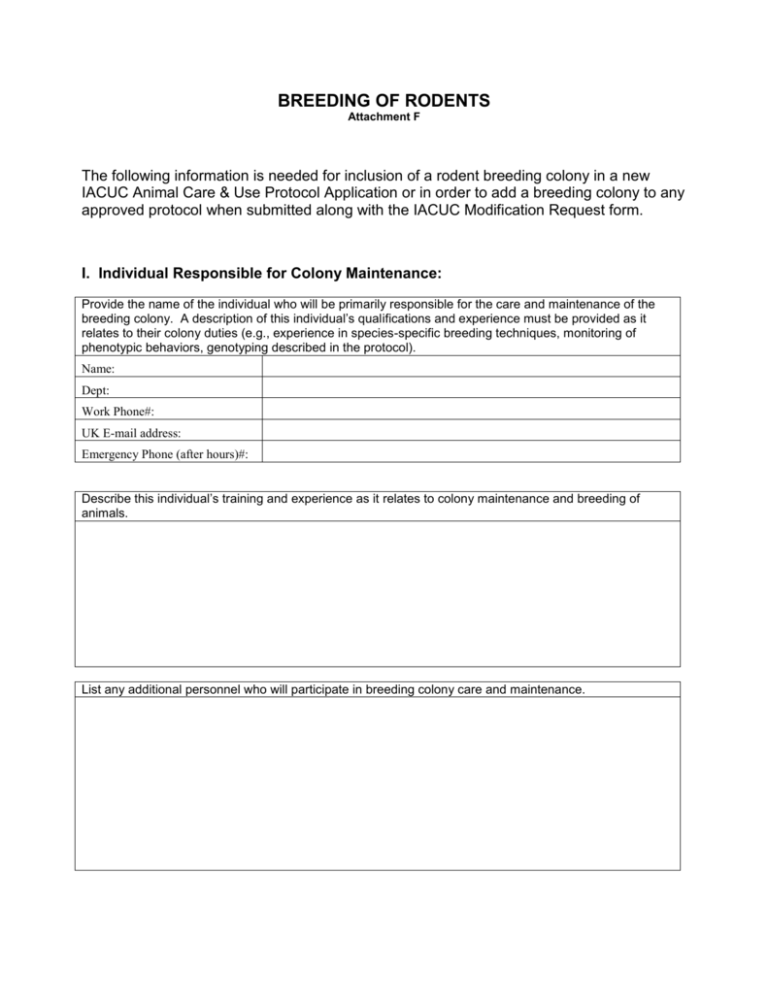
BREEDING OF RODENTS Attachment F The following information is needed for inclusion of a rodent breeding colony in a new IACUC Animal Care & Use Protocol Application or in order to add a breeding colony to any approved protocol when submitted along with the IACUC Modification Request form. I. Individual Responsible for Colony Maintenance: Provide the name of the individual who will be primarily responsible for the care and maintenance of the breeding colony. A description of this individual’s qualifications and experience must be provided as it relates to their colony duties (e.g., experience in species-specific breeding techniques, monitoring of phenotypic behaviors, genotyping described in the protocol). Name: Dept: Work Phone#: UK E-mail address: Emergency Phone (after hours)#: Describe this individual’s training and experience as it relates to colony maintenance and breeding of animals. List any additional personnel who will participate in breeding colony care and maintenance. II. Breeding Colony Justification: Provide a scientific justification for establishing and maintaining a breeding colony of animals. Include how the colony contributes to the overall objectives of your research and why animals from commercial vendor sources are not appropriate. If breeding is proposed solely to maintain a line for future use, include a discussion about why cryopreservation techniques are not appropriate. III. Animal Requirements to Establish and Maintain the Colony: A. Source of breeders: State the source of the founder animals (e.g., vendor, UK colony, other university colony, government or private organization). B. Strain(s)/Line(s) being bred: List each strain/line being bred using standard genetic nomenclature and provide any lab abbreviations/nicknames used for each strain. For example, Jackson Laboratories stock number 002052 has the strain name B6.129-Apoetm1Unc/J but is often abbreviated as “Apoe -/-“ by lab personnel. The current nomenclature guidelines for mice and rats are available on the Jackson Laboratory website at the following link: http://www.informatics.jax.org/mgihome/nomen/strains.shtml C. Animal Numbers: State the number of breeders for each strain/line that will be necessary to conduct this work. Include the estimated number of animals per year that will be used to maintain the colony (males and females), the number of offspring per year to be used per experiment, and the number of offspring per year deemed unusable as a result of unfavorable genotype, sex, etc. Include any supplemental information as necessary to justify these numbers as well (e.g., issues with fertility, litter size, or other phenotypes affecting breeding that will necessitate greater numbers of breeders.) Attaching a chart or table providing this information is recommended. IV. Colony Maintenance: A. Breeding Scheme: Describe the breeding scheme that will be used for each genetic line/strain [e.g., monogamous pairs, trios (1 male, 2 females per cage), etc.]. Note when males are removed from pregnant females (if applicable), if pregnant or nursing females are housed singly, if females are re-bred immediately post-parturient (as in monogamous pair mating) or post-weaning of their litter, and at what age pups are weaned or euthanatized. Unless scientifically justified, breeding schemes should be designed to be compatible with the IACUC Mouse Housing Density Policy available at the following link: http://www.research.uky.edu/ori/univet/resources/Handbook/hb-services-housing.htm Include a description of other aspects of the breeding scheme such as whether lines are bred as homozygote/heterozygote, hybrids, chimeras, are used for backcrossing or inbreeding, or if there will be use of genetic technologies such as Cre-lox or FLP-FRT strains. A word document or spreadsheet may be attached if additional space is needed. B. Colony Management: Describe how the maintenance of the colony is managed and recorded. Include a brief description of pedigree records, and records of breeding performance (e.g., number of pups born, number of each sex weaned, etc.). You may also attach a copy of your record keeping system. : (2 paragraphs and an attach file option.) C. Phenotypes: Describe any known or expected phenotypes of animals in the colony (e.g., behavioral, anatomical, physiological). Discuss whether the generated mice experience any significant health problems associated with their genetic status (e.g., immunodeficiency, musculoskeletal deficiencies, any problems associated with eating, drinking, metabolism, spontaneous neoplasia) which requires special husbandry or results in pain or distress. Please discuss the severity of symptoms expected in these animals and what measures will be used to assess the symptoms and provide relief from pain or distress, including euthanasia, if necessary. V. Genotyping and Other Procedures: A. Animal Identification: Indicate how animals in the breeding colony will be identified. Check appropriate box. Ear Notch Ear Tag Tattoo Microchip Implant Cage Card Only Other Describe how the identification procedure is performed. B. Genetic Identification: Indicate how animals in the breeding colony will be identified genetically (e.g., by PCR from a tail biopsy). Investigators should refer to IACUC SOP 101 for collection of tail biopsies for genetic analysis. A link to this SOP is available on the University Veterinarian’s website: http://www.research.uky.edu/ORI/univet/index.htm. Please note that anesthesia is required for tail snipping of animals over 21 days of age. : C. Euthanasia: Indicate whether animals that cannot be utilized will be euthanatized in the same manner described in the associated IACUC protocol to use animals. If not, describe the euthanasia method. Note also at what age or breeding performance criteria males and females will be retired. Whenever possible, pups or adult animals that cannot be used should be made available to other researchers for use on IACUC approved protocols. Contact the DLAR offices for more information on these procedures.
